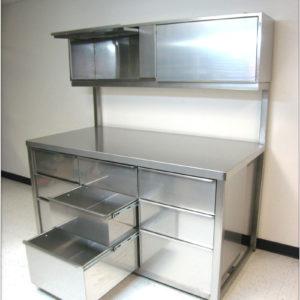Stainless steel cabinets are a popular choice for food factories, as they offer many benefits such as durability, hygiene, and resistance to corrosion. Before making a purchase, one should take into account its disadvantages. In this article, we will discuss the pros and cons of using stainless steel cabinets in a food factory.
Pros:
- They are easy to clean and sanitize. Stainless steel cabinets can be wiped down with a damp cloth or sprayed with a disinfectant solution to remove any dirt, grease, or bacteria. This helps prevent cross-contamination and ensures food safety standards are met.
- They are durable and long-lasting. Stainless steel cabinets are made of high-quality metal that can withstand high temperatures, humidity, and wear and tear. They do not rust, dent, or warp over time. They can also handle heavy loads and equipment without breaking or bending.
- They look stylish, and due to their sleek and shiny appearance, they can enhance the aesthetic. They can also match any color scheme or design theme, as they come in various finishes and sizes. They can create a professional and sophisticated look for your food factory.
- They are eco-friendly and recyclable. Stainless steel cabinets are made of recyclable materials that do not emit harmful chemicals or gases into the environment. They can also be reused or repurposed for other applications, reducing waste and saving resources.
- They are cost-effective and low-maintenance. Stainless steel cabinets may have a higher initial cost than other types of cabinets, but they can save you money in the long run. They do not require frequent repairs or replacements, as they are sturdy and reliable. They retain their color and shine for years.
Cons:
- They are prone to scratches and fingerprints. Stainless steel cabinets can easily get scratched by sharp objects or tools, which can affect their appearance and quality. They can also show fingerprints and smudges, which can make them look dirty and dull. You may need to polish them to keep them shiny and smooth.
- They can produce loud noises when they are opened or closed, which can be annoying and distracting for your workers. They can also feel cold to the touch, which can be uncomfortable for your workers who handle food or equipment. You need to install insulation or soundproofing to reduce the noise and coldness of your cabinets.
- They are strong and resistant to most types of damage, but they are not invincible. They can still get dented by heavy impacts or collisions, which can create uneven surfaces or gaps in your cabinets. They can also corrode if they are exposed to acidic or salty substances.
- They are limited in variety and customization. They have a uniform and standard look that may not suit your personal taste or preference. They may also not fit your specific needs or requirements, as they have limited options for shapes, sizes, colors, and features. You may have to pay extra for custom-made cabinets.
- They are heavy and difficult to install. Stainless steel cabinets are heavier than others, which can make them hard to transport and install. You may need professional help or special equipment to move and mount them on your walls or floors. You will need to reinforce your walls or floors to support the weight of your cabinets.
Closing thoughts
From the aforementioned, it is clear that there are both advantages and disadvantages to owning and using stainless steel cabinets at a food factory. But it’s also interesting to note that most of the cons can be fixed if you opt for a customized cabinet made of steel.



